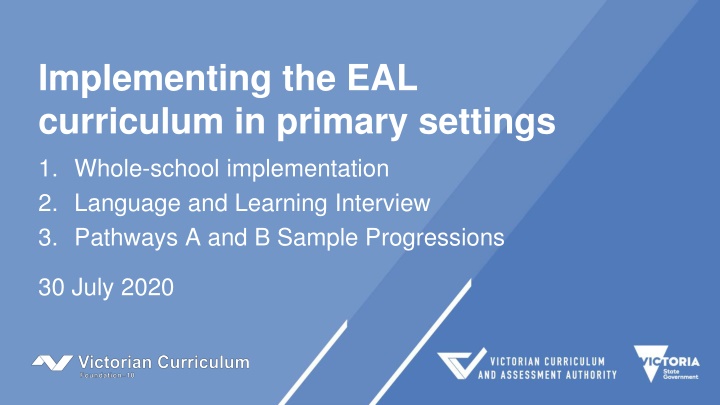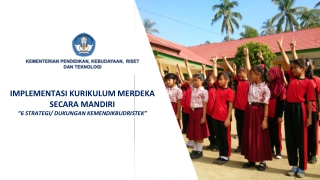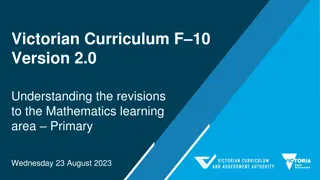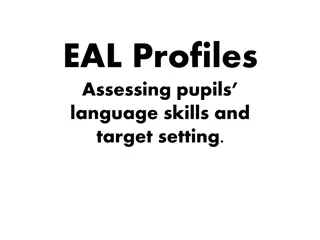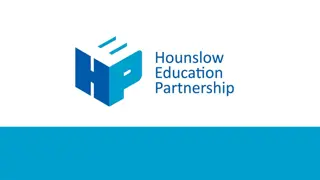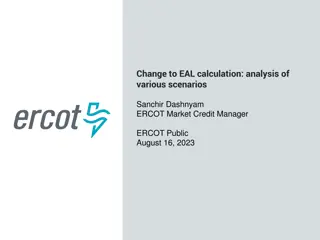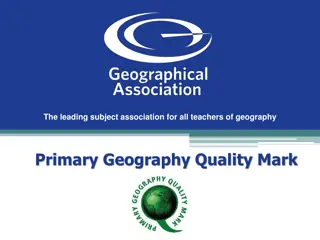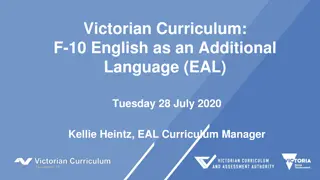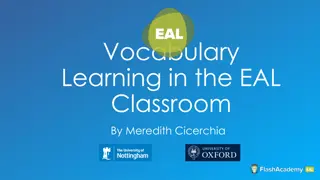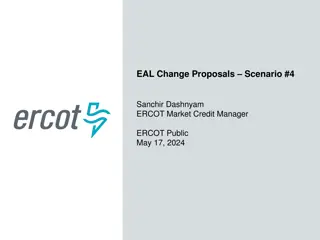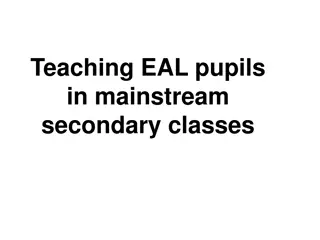Implementing EAL Curriculum in Primary Schools: A Comprehensive Guide
This comprehensive guide explores the whole-school implementation of the English as an Additional Language (EAL) curriculum in primary settings. It includes insights on assessing student learning data, aligning teaching programs with the new curriculum, setting goals, and integrating EAL support with existing school initiatives. The focus is on creating a supportive environment for EAL learners to access and demonstrate learning across all areas using English.
Download Presentation

Please find below an Image/Link to download the presentation.
The content on the website is provided AS IS for your information and personal use only. It may not be sold, licensed, or shared on other websites without obtaining consent from the author.If you encounter any issues during the download, it is possible that the publisher has removed the file from their server.
You are allowed to download the files provided on this website for personal or commercial use, subject to the condition that they are used lawfully. All files are the property of their respective owners.
The content on the website is provided AS IS for your information and personal use only. It may not be sold, licensed, or shared on other websites without obtaining consent from the author.
E N D
Presentation Transcript
Implementing the EAL curriculum in primary settings 1. Whole-school implementation 2. Language and Learning Interview 3. Pathways A and B Sample Progressions 30 July 2020
Acknowledgment of Country In recognition of Aboriginal and Torres Strait Islander people s spiritual and cultural connection to country, we acknowledge the traditional custodians of the Kulin Nations. We acknowledge the continued care of the lands and waterways over generations and celebrate the continuation of a living culture that has a unique role in this region. We pay our respects to Elders past, present and emerging, for they hold the memories, traditions, culture and hopes of all Aboriginal and Torres Strait Islander peoples across the nation and hope they will walk with us on our journey.
A curriculum across all learning areas The Victorian Curriculum F-10 EAL recognises that students need to access and to demonstrate learning in all learning areas using English. This means that all teachers need to: be aware of who the EAL learners are in their classrooms understand the proficiency levels of their EAL learners focus on teaching the content-specific language students need to access the content of their learning areas be able to plan for and support the language learning of EAL students in order to support their understanding of the learning area content. The Department s EAL curriculum school implementation guide is aligned to the FISO Improvement Cycle, and provides detailed recommendations on how to implement the EAL curriculum using a whole-school approach.
Stage 1: Evaluate and diagnose Assessing current student learning EAL data (Panorama dashboard, School Information Portal, CASES21 report ST21905) Student work and information from formative assessments or diagnostic assessments Understanding the new EAL curriculum Evaluating current EAL teaching and learning programs How well is the school s current EAL teaching and learning program differentiated to support EAL student learning? How well is the current EAL teaching and learning program aligned to the new EAL curriculum? Role of the specialist EAL teachers and the classroom teachers
Stage 2: Prioritise and set goals Assessment Pedagogical knowledge Teaching plans Whole-school EAL approach Alignment to other school initiatives
Stage 3: Develop and plan Translate your priorities and goals into plans. For teachers, this could mean considering: the type of assessments you need for different purposes how curriculum area plans, year level plans, and units of work need to change to align to the EAL curriculum and better support EAL learners what needs to be change about reporting on EAL student learning. School leaders may want to consider ways to provide resources to support teachers in their development and planning, for example, providing time for collaboration and the sharing of expertise or supporting attendance at relevant professional learning events. There are resources to support implementation of the EAL curriculum to help teachers and school leaders to understand, teach and assess EAL learners.
Stage 4: Implement and monitor Teachers and school leaders will need to implement plans, trial new practices, monitor student learning and adjust plans in a continuous cycle. You could plan for specific times of the year to: review EAL teaching and learning programs formally monitor EAL student learning and teaching against the curriculum. Milestone dates can help you review progress formally and have discussions with other teachers.
Collaboration School leaders could consider how this changes the whole-school EAL approach. This may mean changing: how all teachers of EAL learners work together who is involved in EAL planning who has oversight of the EAL program. Consider how to provide opportunities for specialist EAL teachers to work collaboratively with classroom teachers and other specialist teachers, to plan and deliver teaching and learning that improves outcomes for EAL students across all learning areas and capabilities of the Victorian Curriculum.
Assessment and reporting against the EAL curriculum An EAL learner s English language proficiency is assessed against the EAL curriculum until their proficiency in all three language modes approximate that of their peers. Specialist teachers report on their learning area content. For further advice and information about assessment and reporting, see Assessment of Student Achievement and Progress Foundation to 10.
Overview of Language and Learning interview The purpose of the interview is to find out about the student s prior learning experiences, including: their development of literacy in their home language or other languages any previous learning of English. This, along with other student assessment tasks, will assist in determining the most suitable EAL pathway for the student to start on. The Language and Learning Interview is a starting point only. It can be used as the starting point to developing a sociolinguistic profile of the EAL student. Schools are encouraged to modify or extend the interview to suit their context and needs.
Question 1: main language used at home NO Is the main language used at home a language other than English? As most families would answer Yes, take this opportunity to explore further. Some parents may think that answering Nois the right answer. In some circumstances parents or carers may answer No because the student: is an international student living with an English-speaking host family was adopted from overseas by an English-speaking family is part of a bilingual or multilingual family using English as one of the languages in the home. The interviewing teacher will need to ask additional questions to find out which language the student mostly uses at home. In these circumstances it is appropriate to answer Yes to this question. If the answer is definitely No, the student may still require EAL support and will benefit from EAL-informed teaching practices.
Question 2: prior schooling Did [name of student] attend school before arriving in Australia? 2.1.1 How long did [name of student] attend school in their country of origin? 2.1.2 How would you describe the extent of [name of student] s prior school learning? 2.2 Why didn t [name of student] attend school?
Question 3: home language literacy What can [name of student] read and write in their home language? Language and literacy levels in the home language and/or other languages are likely to reflect the experience of formal schooling in the student s country of origin. Some students will have been educated to an age-equivalent level in their home country. This foundation in their learning will help them to transition to school life in Australia, even if they cannot yet speak English. Students competence in learning to read and write in English is likely to be linked to their proficiency in their first language, in terms of oracy and literacy. All language skills are an asset in learning a new language. Recognising and supporting these plurilingual skills in the classroom supports student wellbeing and engagement. Students enrolling in Foundation are not expected to have literacy skills in any language when they start school. However they can speak and understand their home language and this can still be used to support their learning at school.
Question 4: time spent learning and using English Has [name of student] learnt or used English before? YES The answers to Question 4 will provide some information about the student s English language proficiency, however, more structured assessments will need to be carried out by the classroom teacher in order to determine the student s level and beginning pathway on the Victorian Curriculum F- 10 EAL. 4.1 How did [name of student] learn English? 4.2 How long has [name of student] been learning or using English? 4.3 What can [name of student] do in English? The checklist in Question 4.3 might form part of these classroom assessment activities. The parents, carers or students may or may not be able to answer this in an interview. Suggested initial diagnostic assessment activities for primary and secondary students are available from the TEAL assessment resource centre.
Questions 5 and 6: experience of education in Australia 5. How long has [name of student] lived in Australia? Finding out about a student s prior experience of Australian schools will help the enrolling school determine the most appropriate EAL pathway for him or her. 6.1 Has [name of student] previously attended preschool or school in Australia? If the student has previously been enrolled in a Victorian government school, the CASES21 report ST21095 should provide any previous assessment data entered by that school. 6.2 Which statement best describes [name of student] s experience and progress at school in Australia (according to observations of the teacher with input from the student and family)?
Question 6: personal information 6.3 Ask the student: What are your interests? What are you good at? 6.4 Ask the student: What would you like us to know about you? 2.2 Ask the parent or guardian: What would you like us to know about [name of student]?
Sociolinguistic profiles Schools can use the information gathered during the Language and Learning Interview to develop sociolinguistic or learner profiles. A sociolinguistic profile recognises that an EAL student s ability to learn English is impacted by their prior learning, cultural background and life experiences. It provides information that teachers can use to cater for their individual needs, and to understand the plurilingual nature of each student. It is a living document that should continue to develop as the student s sociolinguistic profile develops. Best practice sociolinguistic profiles contain information about: student and family language and literacy experience, practices and proficiencies experiences impacting on learning such as where the student was born, their journey to Australia, if there was any trauma involved, previous education any family the student has for support in Australia dietary requirements, medical issues reports from previous schools including transition reports from intensive English language programs and past school reports and/or academic records from other countries.
Next steps information for teachers Communicate key information impacting on the student s proficiency and capacity to learn to the appropriate staff. At a minimum this would be the student s classroom teacher in a primary setting. However, it is important to develop a process that provides the relevant information to all of the student s teachers, as all teachers have responsibility for supporting the English language learning and welfare as well as the content learning of the student. The information gathered during the interview will assist the responsible teacher or teachers to make decisions about which level and pathway is most appropriate for the student. Gathering and sharing information is an ongoing process.
3. Pathways A and B sample progression
EAL Pathways The Victorian Curriculum F-10 EAL pathways are based on immersion points . Although there are age-related considerations in determining the most appropriate pathway, schools have some flexibility in making these decisions. The overlap between the pathways (Years 2 to 8) offers schools some flexibility in determining the most appropriate developmental pathway for each EAL student.
What do the levels in Pathway A mean? EAL Pathway A: early immersion (Foundation to Year 2) EAL learners at Pathway A: are in the early years of their lives and are still exploring the world through concrete experiences typically develop their language and literacy skills through experiences in the school context may have some experience of informal prior learning or preschool in Australia or overseas may have some experience of formal learning in their home language or other languages are able to interact and communicate using known languages and non-verbal language. Two levels of language learning in EAL Pathway A: A1 little or no experience of literacy in English A2 emerging/consolidating levels of English proficiency Generally students who enter Foundation are pre-literate, regardless of their language background, and hence there is no Level AL. EAL students who enter Foundation with minimal literacy in other languages will begin their early immersion in English at Level A1.
What do the levels in Pathway B mean? EAL Pathway B: mid immersion (Years 2 to 8) EAL learners at Pathway B: have approximately seven to 13 years of life experiences, and have developed some understanding of the world may have some experience of informal learning in their home language or other languages may not have experienced formal schooling in any language may have experienced formal learning (in home language or other languages) that is equivalent to their English- speaking peers have experience of the social use of at least one language, which they can use as they learn English at school. Four levels of language learning: BL no or limited prior formal learning and no or limited levels of literacy in English and first language B1 with prior experience of formal learning, beginner levels of English proficiency B2 with prior experience of formal learning, emerging levels of English proficiency B3 with prior experience of formal learning, consolidating levels of English proficiency EAL learners without prior formal learning and with minimal home language literacy experience will begin this pathway at Level BL. Depending on their proficiency in English, learners with prior experience of formal learning may begin Pathway B at any other level.
Pathway A sample progression Primary carers did not move to Australia with child. Some literacy skills in first language. Ongoing development of L1. Changes in home situation that could impact learning. Ongoing arrangements at home that could impact learning. Adapted from VCAA s Sample progressions through the EAL Pathways
Pathway A sample progression Adapted from VCAA s Sample progressions through the EAL Pathways
Pathway B sample progression Adapted from VCAA s Sample progressions through the EAL Pathways
Pathway B sample progression Adapted from VCAA s Sample progressions through the EAL Pathways
Supporting Amin Amin is 9 years old. He is working at the beginning of B2. His class teacher uses EAL- informed strategies to support his learning and he receives additional EAL support from a specialist teacher and a Multicultural Education Aide. Amin is curious and confident in his learning.
Using the EAL curriculum LEVEL 4 WRITING PLANNER Purpose: For EAL students to research, plan, draft and publish an information report. Adapted from VCAA s examples of whole-school curriculum plans English Level 4 Content Descriptions (Writing) EAL B2 Content Descriptions (Speaking and listening) EAL B2 Content Descriptions (Reading and viewing) EAL B2 Content Descriptions (Writing) Plan, draft and publish imaginative, informative and persuasive texts containing key information and supporting details for a widening range of audiences, demonstrating increasing control over text structures and language features (VCELY299) Communication Use a repertoire of common classroom and schoolyard language (VCEALC325) Cultural understandings Identify the purpose and structure of a small range of texts (VCEALA352) Communication Write simple factual texts (VCEALC376) Text structure and organisation Identify informative, imaginative and persuasive texts when reading texts or listening to texts read aloud (VCEALL360) Understand the purpose and organisational features of common text types (VCEALL361) Cultural understandings Plan, with support, the format of a text according to its communicative purpose (VCEALA381) Draft a piece of writing focusing on meaning, and revise after rereading or discussion (VCEALA382) Cultural understandings Participate appropriately in social and learning situations (VCEALA329) Understand that the meaning of sentences can be enriched through the use of noun groups/phrases and verb groups/phrases and prepositional phrases (VCELA292) Grammatical patterns Use a range of verb forms with increasing accuracy (VCEALL336) Grammatical patterns Read texts that contain compound and complex sentences (VCEALL364) Grammatical patterns Write sentences with some common errors (VCEALL390) Use a range of verb forms correctly (VCEALL391) Word knowledge Use, in speech, vocabulary and structures learnt from spoken and written texts (VCEALL341) Multiple exposures to target language across all three modes
Differentiated teaching for EAL students WRITING LESSON PLAN Purpose: To understand the text structures and linguistic features of an information report. English 1. Provide students with a range of information reports. Do not reveal genre. EAL differentiated teaching Provide EAL students with two information reports with similar structures and written in accessible language, with organisational features such as sub headings for each paragraph. Provide EAL students with a checklist of language features to identify. For example, does this text use: proper nouns or common nouns present tense verbs or past tense verbs? Use the checklist and refer to posters of text types to determine the genre. EAL students contribute to discussion using their checklist. 2. Students work in groups to look at language features (highlight and annotate). What are the similarities and differences? What are the features? Try to determine the genre. 3. Share findings and reveal genre. Create class poster on features of information reports. Adapted from VCAA s examples of whole-school curriculum plans
Supporting EAL learners in all curriculum areas The EAL curriculum helps you to understand the support that EAL learners need to understand, speak, listen, read, view and write in different curriculum areas, depending on their levels in each of the three language modes of the curriculum. Adapted from VCAA (2019) Victorian Curriculum F-10 EAL Science EAL Level BL EAL Level B1 EAL Level B2 EAL Level B3 Chemical sciences A change of state between solid and liquid can be caused by adding or removing heat (VCSSU059) Speaking and listening Identify basic items of information in short spoken texts (VCEALC167) Identify some key points of information in short spoken texts, with guidance (VCEALC245) Identify key points of information in short spoken texts (VCEALC326) Understand a new topic delivered with extensive contextual and teacher support (VCEALC406) Questioning and predicting With guidance, identify questions in familiar contexts that can be investigated scientifically and predict what might happen based on prior knowledge (VCSIS065) Reading and viewing Acquire information from simple images, with teacher direction and support (VCEALC186) Acquire some information from a small range of images (VCEALC266) Acquire information from different types of visual representations in text (VCEALC347) Interpret and explain information from a range of images in text (VCEALC426) Communicating Represent and communicate observations, ideas and findings to show patterns and relationships using formal and informal scientific language (VCSIS072) Writing Copy words, phrases or sentences accurately and carefully (VCEALC216) Write simple factual texts using print and computers or other digital devices for a variety of classroom purposes (VCEALC296) Write simple factual texts (VCEALC376) Write a range of texts covering topics across the curriculum areas, incorporating information from different sources (VCEALC455)
CONTACT LINKS For any questions concerning the EAL curriculum, please contact: EAL Regional Program Officers VicTESOL Kellie Heintz, EAL Curriculum Manager, VCAA Victorian Curriculum F-10 EAL Language and learning interview Sample progressions through the EAL Pathways Pathways through the EAL curriculum (DET adaptation) TEAL assessment resources Assessment of Student Achievement and Progress Foundation to 10 First language assessment materials EAL curriculum school implementation guide Resources for implementing the new EAL curriculum Kellie.Heintz@education.vic.gov.au
